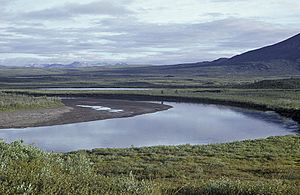Sheenjek River facts for kids
Quick facts for kids Sheenjek River |
|
|---|---|

Flowing through Yukon Flats National Wildlife Refuge
|
|
|
Location of the mouth of the Sheenjek River in Alaska
|
|
| Country | United States |
| State | Alaska |
| District | North Slope Borough, Yukon–Koyukuk Census Area |
| Physical characteristics | |
| Main source | Brooks Range slightly south of the Continental Divide, North Slope Borough 6,079 ft (1,853 m) 69°01′53″N 144°00′40″W / 69.03139°N 144.01111°W |
| River mouth | Porcupine River 23 miles (37 km) northeast of Fort Yukon, Yukon Flats National Wildlife Refuge 446 ft (136 m) 66°44′23″N 144°34′01″W / 66.73972°N 144.56694°W |
| Length | 200 mi (320 km) |
| Type: | Wild |
| Designated: | December 2, 1980 |
The Sheenjek River is a long river in Alaska, United States. It flows for about 200 miles (320 km). This river is a branch of the larger Porcupine River.
The Sheenjek River starts in the eastern part of the Brooks Range mountains. It then flows south until it joins the Porcupine River. This meeting point is northeast of a town called Fort Yukon.
The name "Sheenjek" comes from the Gwich'in people. Their word "khiinjik" means "dog-salmon river." An early explorer, J.H. Turner, even called it the Salmon River. This shows how important salmon are to the river.
The area near the Sheenjek River's source is very remote. It is one of the farthest places from human roads or towns in the United States.
Boating on the Sheenjek River
The Sheenjek River is a great place for boating. You can explore it using different types of boats. The best time to go boating is from June to late September.
River Difficulty for Boaters
The upper part of the river is mostly Class II. This means it has some rapids that are medium difficulty. The lower part of the river is Class I, which is easy. However, if it rains a lot, the river can rise quickly. This can make the water faster and more challenging.
Staying Safe on the River
When boating, it's important to be aware of your surroundings. In the upper river, some parts can be very shallow. The river also splits into many small channels, which can be tricky.
You might also see "aufeis" in colder times. This is a type of ice that forms on top of other ice. Along the whole river, watch out for tree branches hanging over the water. Also, be careful of logs hidden under the surface. In late summer and early fall, bears might be active near the lower parts of the river. Always follow safety guidelines when exploring nature.


